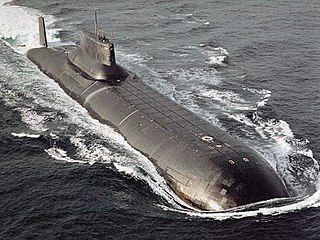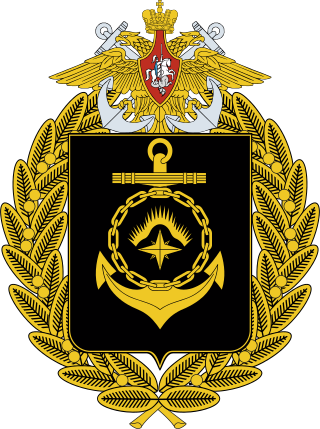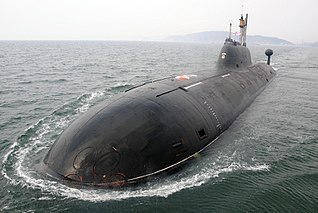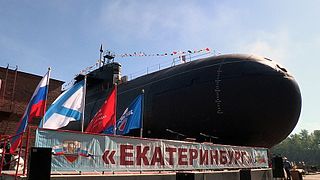
The Oscar class, Soviet designations Project 949 Granit and Project 949A Antey,, are a series of nuclear-powered cruise missile submarines designed in the Soviet Union for the Soviet Navy. They are currently in service with the Russian Navy with some of the vessels planned to be modernized as Project 949AM, to extend their service life and increase combat capabilities.

A ballistic missile submarine is a submarine capable of deploying submarine-launched ballistic missiles (SLBMs) with nuclear warheads. The United States Navy's hull classification symbols for ballistic missile submarines are SSB and SSBN – the SS denotes submarine, the B denotes ballistic missile, and the N denotes that the submarine is nuclear powered. These submarines became a major weapon system in the Cold War because of their nuclear deterrence capability. They can fire missiles thousands of kilometers from their targets, and acoustic quieting makes them difficult to detect, thus making them a survivable deterrent in the event of a first strike and a key element of the mutual assured destruction policy of nuclear deterrence.

The Typhoon class, Soviet designation Project 941 Akula, is a class of nuclear-powered ballistic missile submarines designed and built by the Soviet Union for the Soviet Navy. With a submerged displacement of 48,000 tonnes, the Typhoons are the largest submarines ever built, able to accommodate comfortable living facilities for the crew of 160 when submerged for months on end. The source of the NATO reporting name remains unclear, although it is often claimed to be related to the use of the word "typhoon" ("тайфун") by General Secretary Leonid Brezhnev of the Communist Party in a 1974 speech while describing a new type of nuclear ballistic missile submarine, as a reaction to the United States Navy's new Ohio-class submarine.

The Akula class, Soviet designation Project 971 Shchuka-B are a series of fourth generation nuclear-powered attack submarines (SSNs) first deployed by the Soviet Navy in 1986. There are four sub-classes or flights of Shchuka-B, consisting of the original seven Project 971 boats, commissioned between 1984 and 1990; six Project 971Is, commissioned between 1991 and 2009; one Project 971U, commissioned in 1995; and one Project 971M, commissioned in 2001. The Russians call all of the submarines Shchuka-B, regardless of modifications.

The Northern Fleet is the fleet of the Russian Navy in the Arctic.

The Delta class, Soviet designations Project 667B Murena, Project 667BD Murena-M, Project 667BDR Kalmar, Project 667BDRM Delfin, are a series of nuclear-powered ballistic missile submarines, designed and built in the Soviet Union, which formed the backbone of the Soviet and Russian strategic submarine fleet since their introduction in 1973. They carry nuclear ballistic missiles of the R-29 Vysota family, with the Delta I, Delta II, Delta III and Delta IV classes carrying the R-29, R-29D, R-29R and R-29RM respectively. The Delta I class carried 12 missiles, while the Delta II class which are lengthened versions of the Delta I class carry 16 missiles. The Delta III and Delta IV classes carry 16 missiles with multiple warheads and have improved electronics and noise reduction. 34 boats were built and commissioned during 1972–1990; approximately five or six remain active in 2023.

An SSN is a nuclear-powered general-purpose attack submarine. SSN is the US Navy hull classification symbol for such vessels; the SS denotes a submarine and the N denotes nuclear power. The designation SSN is used for interoperability throughout NATO under STANAG 1166, though navies use other terms.

The RSM-56 Bulava is a submarine-launched ballistic missile (SLBM) developed for the Russian Navy and deployed in 2013 on the new Borei class of ballistic missile nuclear submarines. It is intended as the future cornerstone of Russia's nuclear triad, and is the most expensive weapons project in the country. The weapon takes its name from bulava, a Russian word for mace.

The Borei class, alternate transliteration Borey, Russian designation Project 955 Borei and Project 955A Borei-A, are a series of nuclear-powered ballistic missile submarines being constructed by Sevmash for the Russian Navy. The class is projected to replace the Soviet-era Delta III, Delta IV and Typhoon classes in Russian Navy service.

Dmitriy Donskoy is a Russian Navy nuclear ballistic missile submarine, designated Project 941 Akula class.
Project 210, Project 10831 or AS-31, nicknamed Losharik, is a Russian deep-diving nuclear powered submarine. On 1 July 2019, a fire broke out on the vessel while it was taking underwater measurements of the sea floor in Russian territorial waters.

The Yasen class, Russian designations Project 885 Yasen and Project 885M Yasen-M, also referred to as the Graney class, are a series of nuclear-powered cruise missile submarines designed by the Malakhit Marine Engineering Bureau and built by Sevmash for the Russian Navy. Design work commenced in earnest in the 1980s with the first submarine built in the 1990s–early 2010s with commissioning in 2013. Two additional boats to a modified Yasen-M design were commissioned in 2021 and six more are under construction. Based on the Akula class and Alfa class designs, the Yasen class is projected to replace the Russian Navy's current Soviet-era nuclear attack submarines. The Akula class is optimised for a hunter-killer role, whereas the Yasen class concept uses the platform as a nuclear guided missile submarine (SSGN).

Nerpa is a 8,140-tonne (8,010-long-ton) Project 971 nuclear-powered attack submarine. The construction of the submarine was started in Russia in 1993, but was suspended due to lack of funding. India then sponsored further construction and sea trials of the submarine provided it was leased to the Indian Navy for 10 years. It was launched as K-152 Nerpa in October 2008 and entered service with the Russian Navy in late 2009. The submarine was leased to the Indian Navy in 2011 after extensive trials, and was formally commissioned into service as INS Chakra with the Eastern Naval Command at a ceremony in Visakhapatnam on 4 April 2012. In June 2021 Chakra was spotted on the surface escorted by Indian and Russian warships in the Singapore Strait while presumably heading towards the Russian naval base in Vladivostok; some media speculated that she was returning to Russia before the expiry of the lease term.

The R-29RMU2 Sineva, code RSM-54, is a Russian liquid-fueled submarine-launched ballistic missile with GRAU index 3M27, designation SS-N-23A Skiff. It can carry four warheads and is designed to be launched from Delta IV-class submarines, which are armed with 16 missiles each. As of 2017, there are 96 launchers deployed on the submarines.

Krasnoyarsk Cheremshanka Airport is a domestic airport in the Krasnoyarsk Krai, situated 23 kilometres (14 mi) northwest of Krasnoyarsk. It became the base of a civil defense helicopter detachment in 1982, featuring Mil Mi-6 and Mil Mi-8 aircraft. In addition to military use, the airfield serves some regional civilian passenger flights using Antonov An-24 and Antonov An-26 aircraft. It is the hub of KrasAvia airline. Krasnoyarsk Cheremshanka is adjacent to the larger Krasnoyarsk International Airport and appears very similar to it from the air, since its two runways, although shorter than those at the international airport, have the exact same bearings (11/29).

The Pacific Fleet is the Russian Navy fleet in the Pacific Ocean.

K-84 Ekaterinburg is a Project 667BDRM Delfin-class nuclear-powered ballistic missile submarine. The submarine was laid down on 17 February 1982 at the Russian Northern Machine-Building Enterprise (Sevmash). It was commissioned into the Soviet Navy on 30 December 1985. After the collapse of the Soviet Union, the submarine continued to serve in the Russian Navy. Initially known only by her hull number, in February 1999 she was renamed after the city of Yekaterinburg.
The R-29RMU2.1 Layner is a Russian liquid-fuelled submarine-launched ballistic missile (SLBM) and the newest member of the R-29 missile family, developed by the Makeyev Rocket Design Bureau and produced by the Krasnoyarsk Machine-Building Plant. Derived from the R-29RMU2 Sineva SLBM, the Layner can carry twelve nuclear warheads, three times as many as Sineva. It was expected to enter service with the Russian Navy's Delta IV-class submarines after a successful test programme that spanned from May to September 2011. The Russian Navy confirmed in 2014 that the system was now in use.

The K-335 Gepard is an Akula-class submarine in the Russian Navy.
















